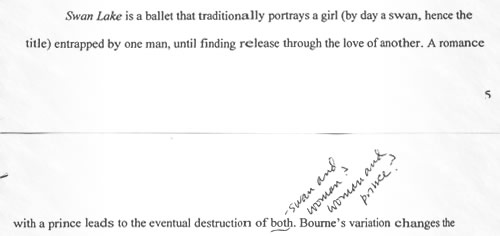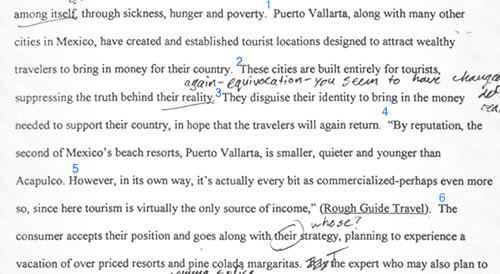
 — Unclear Antecedent
— Unclear Antecedent
If readers of your writing pepper the margins with comments such as "what?," "which?," and
"who?," then they may be having trouble identifying the antecedents of your pronouns.
Let's take a look at a few examples of this kind of problem and how to correct it.
 In this example,
the antecedent of "both" is unclear. Is the writer referring to "swan and
woman" or "woman and prince" (or perhaps to both of the men mentioned).
In this example,
the antecedent of "both" is unclear. Is the writer referring to "swan and
woman" or "woman and prince" (or perhaps to both of the men mentioned).
The only way to avoid this ambiguity is to identify the nouns, as in " . . . leads to the eventual destruction of both the woman and the prince."
The following example illustrates the same kind of problem, but in this case, the writer uses “them” and “their” without providing a clear antecedent.
 The writer uses "they" and "their" without a clear referent in these sentences. The instructor indicates this ambiguous pronoun reference by asking "whose?" when the
writer refers to "their strategy" in sentence 6.
The writer uses "they" and "their" without a clear referent in these sentences. The instructor indicates this ambiguous pronoun reference by asking "whose?" when the
writer refers to "their strategy" in sentence 6.
Starting in sentence 1, "their (country)"
doesn't have a definite antecedent nearby (although
logically "their" may refer to
“Mexican people”). However, in the following
sentence, the same pronoun “their (reality)”
seems to refer to another antecedent, this time with
“cities” as the antecedent. Yet, in the very
next sentence (sentence 3), the writer switches the
pronouns “they” and “their (identity)”
back to “Mexican people,” without any
antecedent previously mentioned.
The problem
becomes worse in sentence 6, because this time the reader
cannot find an antecedent for the pronoun. In “the consumer accepts their
position and goes along with their strategy,” the
pronoun “their” cannot be pinned down to any
specific noun. “Their” cannot refer to Puerto
Vallarta (which, if anything, requires the pronoun
“its”), and “their” cannot refer
to Mexican people because it would include all people in
Mexico, when the sense here should only be specific to
people in Puerto Vallarta, nor can “their”
refer to “the consumer” here. Could, then,
“their” refer to people in Puerto Vallarta? Perhaps.
But it could also refer, logically, to the city council,
who makes decision and strategies for tourism, too. In any
case, the reader is not sure to whom
“their” refers. So, the only way to solve
the problem is to reduce the reliance on “their” in this passage and supply a clear referent.
Let's look at the last example below. See if you can identify and solve the problem.
 In this example, the reader cannot tell from context what "it" refers to.
In this example, the reader cannot tell from context what "it" refers to.
In this case, the pronoun "it" doesn't have an antecedent. "It" cannot refer to Paradise Lost, because the subject of the verb to say should be a person. However, you can easily remedy the ambiguity with the following:
Or, even more simply:
Both sentences read much clearer because the pronoun "it" has been replaced with a noun. The effect is that readers know who or what performs the action in the sentence, leaving no room for confusion or questions begging for clarity.
Back to Ask Betty's Instructor Comments Workshop